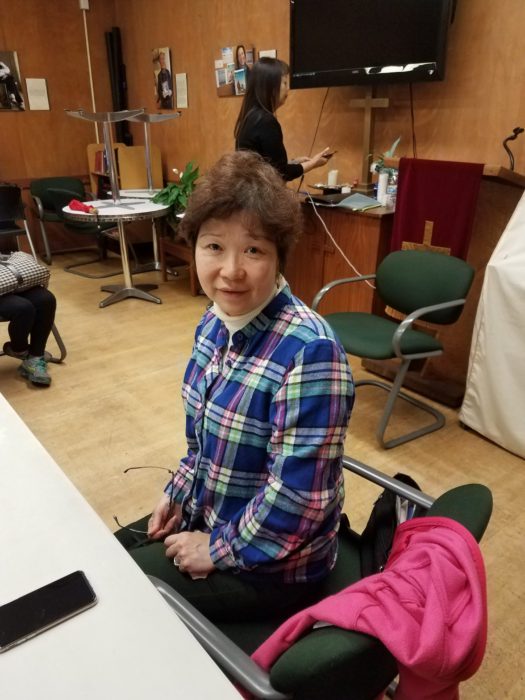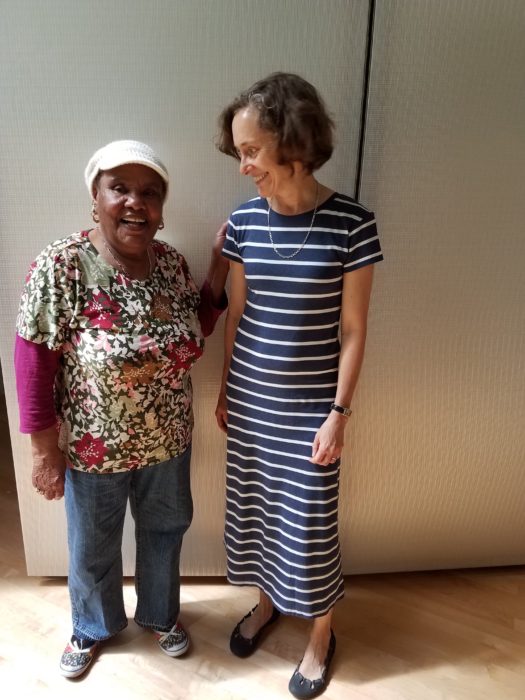Smart phones and devices offer seniors new skills to thrive in the digital world
Tindy Lee, 66, learned how to use YouTube to connect to the TV so she didn’t have to pay to stream shows anymore. And now she’s an avid user – connecting with Facebook, calling family and friends on WeChat, checking the weather, taking photos and using calendar alerts to help her keep track of her mother-in-law doctor’s appointments.
“Before I took this class, the only thing I did with my phone was turn it on and off,” she said. Now, when Lee leaves town, she takes her phone and buys a card.

Una Johnson uses her iPad and email to stay connected to friends, family and her native Jamaica. Since settling in the Bay Area in 1979, the 82-year-old has seen many friends move away. Her family lives in England and Canada. On the iPad, she’s able to view her brother’s street in London and enjoy virtual walks around her old neighborhood in Kingston.

In myriad ways, seniors not raised in the digital age are finding technology can be of help. Because social engagement is important to seniors’ health and well being, many San Francisco agencies are showing them how technology can help them answer health questions, keep current with world affairs, learn about community events, shop, maintain contact with friends and family, and make new connections.
Johnson learned how to use her iPad after signing up for a friendly visitor through Little Brothers-Friends of the Elderly. The program had just launched Tech Allies, in which training in the use of digital devices is integrated into visits. Her companion was LBFE volunteer Jane Day, a tech writer for a local software firm.
Super-user Lee acquired her digital skills through Linda Ling Hong, a retired IT manager working with Self-Help for the Elderly. She teaches Chinese seniors in weekly classes at the OMI Senior Center, Jackie Chan Center, Mission Neighborhood Center and Western Park Apartments.
Hong also shares some practical uses for handheld devices. Hong recalls a student who was unable to get a cell phone connection while at her husband’s emergency room bedside. She was told the only way to connect was to leave his room. But she didn’t want to. Hong taught the class how to connect to WiFi, or to hand their phone to someone and say, “WiFi please.”
Seniors ‘getting with’ digital
While few among the oldest segment of the population are likely to start using the Internet without some assistance and encouragement, according to a 2018 AARP survey, younger seniors are increasingly embracing technology.
The survey found that the majority of older adults use their cell phones beyond just chatting and texting: 79 percent send emails, 80 percent exchange photos, 37 percent video chat, while 62 percent connect through social media – with sizable shares of each of these groups are doing each of these daily.
The Internet was also useful for developing friendships: 24 percent of those surveyed by AARP have made at least one friend online, with almost half, 49 percent, taking the next step and meeting their new friend in person.
Five years earlier, a University of Alabama analysis, the Impact of Internet Use on Loneliness and Contact with Others Among Older Adults, showed only half of seniors using the Internet, mostly for email.
Four years ago, when Hong first began teaching, she focused on computer skills. But as more of her students began relying on their smart devices, she tailored her instruction. “I teach what my students use and need. While the centers all have computers, my students rely on their handheld devices so that’s what I teach, she said.

Keeping seniors engaged and connected is an essential goal of many digital literacy training programs. And that sometimes means overcoming psychological resistance or educating seniors in the ways of Internet or Facebook communications.
For example, helping older aadults understand how their grandchildren use their devices. When some of her students complained of feeling hurt when their grandchildren texted photos of restaurant meals, Hong told them, “It’s not that your grandchildren are making fun of your food; it’s a way of sharing what they enjoy with you, a way of saying, “I love you, grandma.” After she taught them how to “like” those posts, several reported that their grandchildren now proudly refer to them as “with it.”
Then there are those who think their their children and grandchildren ought to be teaching them. “They can see that their children and grandchildren are obviously knowledgeable on their devices; they’re on them all the time,” said Hong. ‘I tell them, it’s not that their children are treating them badly. They don’t have the time or knowledge to teach them. They don’t even have the words in Chinese to teach them.”
Translation software
When her students wanted to be able to review their own medical reports, Hong showed them how to use translation software to turn English to Chinese “so they don’t have to wait for their family to read the report, and so that they can study it as often as they want.”
When she was younger and healthier, Johnson loved music, dancing, and visiting family and friends. But later, feeling lonely and with pain from a chronic bone condition, the retired home health care worker attended a Little Brothers-Friends of the Elderly event. There, she met Day and joined the program, which provides an iPad for every senior and helps them enroll in the Comcast Internet Essentials plan.
Johnson uses the iPad to listen to reggae and watch reruns of her favorite TV shows. She and Day took a virtual tour of Trinidad, and of her brother’s home in London. And she renewed ties with an old friend in New York. Day also showed her how to get accurate information online about the new real California ID cards that had confused Johnson.
Connecting to the Internet and using the iPad has expanded Johnson’s world but it’s no substitute for conversation, “I still need a human being – someone I can talk to,” she said.
And every other Sunday afternoon for the last two years that’s been Day. Their friendship goes beyond technology. Day visits Johnson’s brother and sister-in-law on her travels to London. And Johnson, who Day says is “a genius in the kitchen,” prepares food for her to take home.
Other free instruction:
The San Francisco Public Library offers computer instruction at the downtown site and at many neighborhood libraries. Check your local library for information on their classes. You can also check the library newsletter and the library website, https://sfpl.org/index.php?pg=1100000001 for information on classes.
SF Connected, funded by the San Francisco Department of Aging and Adult Services offers digital literacy classes in 50 locations around the City. Classes are taught in English, Spanish, Chinese, Russian,AA and Vietnamese. https://www.sfhsa.org/services/connection-community/sf-connected.





